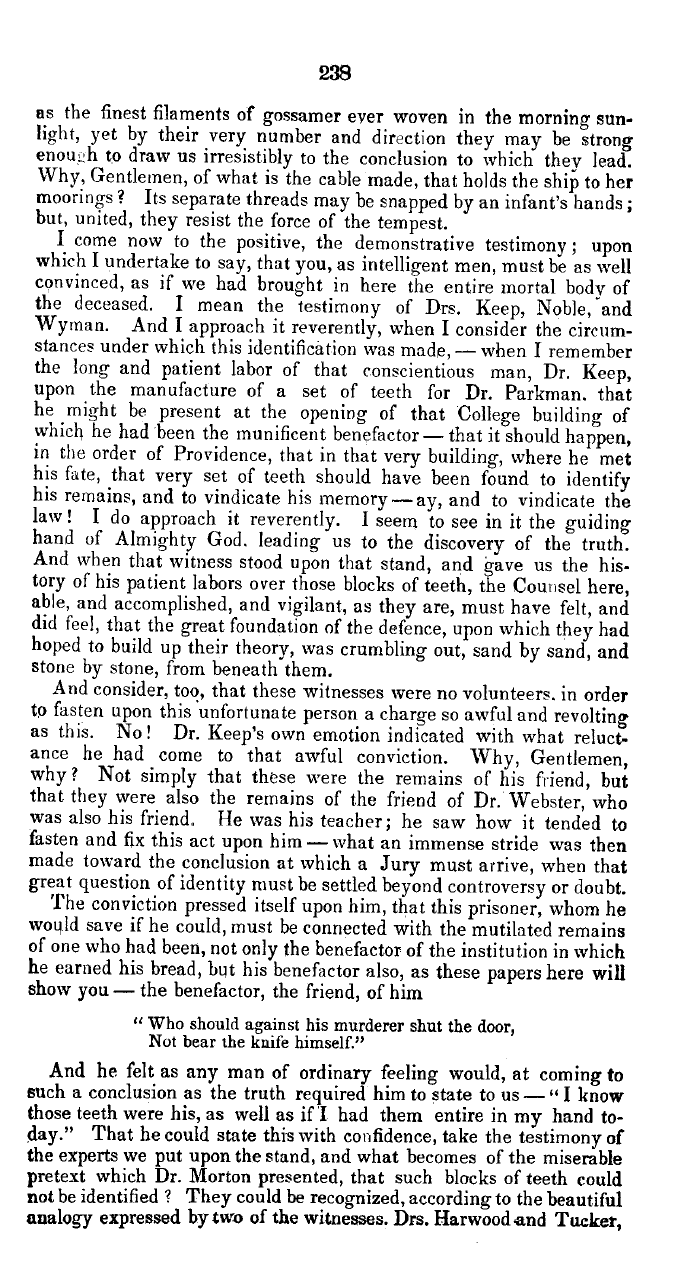|
238
as the finest filaments of gossamer ever woven in the morning sun-
light, yet by their very number and direction they may be strong
enou-h to draw us irresistibly to the conclusion to which they lead.
Why, Gentlemen, of what is the cable made, that holds the ship to her
moorings? Its separate threads maybe snapped by an infant's hands;
but, united, they resist the force of the tempest.
I come now to the positive, the demonstrative testimony; upon
which I undertake to say, that you, as intelligent men, must be as well
convinced, as if we had brought in here the entire mortal body of
the deceased. I mean the testimony of Drs. Keep, Noble, and
Wyman. And I approach it reverently, when I consider the circum-
stances under which this identification was made,-when I remember
the long and patient labor of that conscientious man, Dr. Keep,
upon the manufacture of a set of teeth for Dr. Parkman. that
he might be present at the opening of that College building of
which he had been the munificent benefactor-that it should happen,
in the order of Providence, that in that very building, where he met
his fate, that very set of teeth should have been found to identify
his remains, and to vindicate his memory-ay, and to vindicate the
law! I do approach it reverently. I seem to see in it the guiding
hand of Almighty God. leading us to the discovery of the truth.
And when that witness stood upon that stand, and gave us the his-
tory of his patient labors over those blocks of teeth, the Counsel here,
able and accomplished, and vigilant, as they are, must have felt, and
did feel, that the great foundation of the defence, upon which they had
hoped to build up their theory, was crumbling out, sand by sand, and
stone by stone, from beneath them.
And consider, too, that these witnesses were no volunteers. in order
to fasten upon this unfortunate person a charge so awful and revolting
as this. No! Dr. Keep's own emotion indicated with what reluct-
ance he had come to that awful conviction. Why, Gentlemen,
why? Not simply that these were the remains of his friend, but
that they were also the remains of the friend of Dr. Webster, who
was also his friend. He was his teacher; he saw how it tended to
fasten and fix this act upon him-what an immense stride was then
made toward the conclusion at which a Jury must arrive, when that
great question of identity must be settled beyond controversy or doubt.
The conviction pressed itself upon him, that this prisoner, whom he
would save if he could, must be connected with the mutilated remains
of one who had been, not only the benefactor of the institution in which
he earned his bread, but his benefactor also, as these papers here will
show you-the benefactor, the friend, of him
« Who should against his murderer shut the door,
Not bear the knife himself."
And he felt as any man of ordinary feeling would, at coming to
such a conclusion as the truth required him to state to us-°1 1 know
those teeth were his, as well as if 'I had them entire in my hand to-
day." That he could state this with confidence, take the testimony of
the experts we put upon the stand, and what becomes of the miserable
pretext which Dr. Morton presented, that such blocks of teeth could
not be identified? They could be recognized, according to the beautiful
analogy expressed by two of the witnesses. Drs. Harwoodand Tucker,
|

